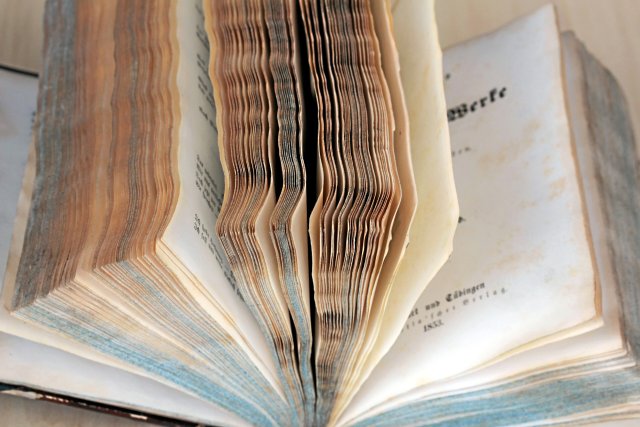Anyone who writes knows: creating works is not easy.
Photo: iStock/Astrid Gast
When Goethe wrote the “West-Eastern Divan” in 1814/15, he was already in his mid-60s. He was inspired by Marianne von Willemer, who was just in her early 30s, an actress and dancer. Goethe shows himself caught up in the frenzy of love, creating over 100 poems in one year! But the young woman is married to a banker, an unfortunate situation for Goethe that soon awakens his instinct to flee.
In his book “Gegenwelten”, which has just been published by quartus Verlag, Klaus Bellin registers the emotional distress of creative people like a seismograph. About Goethe’s hasty return to Weimar it is said: “The summer fairy tale is over.” Goethe now rushes “among a thousand memories,” as he lets Marianne know, “on the direct route back to Weimar, to his wife and his work, the work.”
Where else? Someone like Goethe, who has long since left his impetuous first novel “The Sorrows of Young Werther” behind him in favor of a representative classic security, does not jeopardize his privileged existence because of falling in love. But the aging poet suffers from the separation no differently than a young man – and there are also the first symptoms of old age. Above all, it is the certainty that there is much more behind him than in front of him that he finds difficult to bear.
Klaus Bellin, author (about Kurt Tucholsky, Harry Graf Kessler) and long-time nd critic, who will be 90 next year, only needs a dozen pages to explain the drama of the aging world based on the creation of the “West-Eastern Divan”. To give Goethe a contour. Incidentally, only a few hundred copies of the “Divan” were sold.
Goethe begins this survey of 19th century poets. Their lives, with all their crises and low blows, often don’t seem to match the splendor of the tradition. In an impressive way, Klaus Bellin turns to the seemingly marginal, far more than an academic literary criticism would consider permissible. But this is the only way to get close to people, who often only become creative out of external lack and inner need.
The second text of the book is dedicated to August Goethe, the poet’s sad son, who was essentially his secretary. Always needed, but little appreciated by his father and kept at a distance. He died in Rome in 1830 during a trip to Italy that he had literally begged for from his father. Goethe’s pain over the loss of his son, who remained a stranger to him, was limited. In any case, all of his attention went to his two grandchildren, Walther and Wolfgang, whom he even allowed to play in his study. The highly unfair distribution of sympathies remains a mystery.
nd.DieWoche – our weekly newsletter

With our weekly newsletter nd.DieWoche look at the most important topics of the week and read them Highlights our Saturday edition on Friday. Get your free subscription here.
Many essays about poets write, but very few touch the sore spots of the poet’s soul with such sure instinct. With Bellin, this happens so gently, as if he wanted to ease their pain through understanding. For example, he finds images that reveal life for old Goethe’s visit to Frankfurt am Main, his birthplace. These miniatures result from tactful ruthlessness and discretion that points out discrepancies. For example, when the biographer lets Goethe pass by his birthplace in Frankfurt’s Großer Hirschgraben, which has long belonged to someone else. At exactly that moment, the old grandfather clock inside, which had been left there when the family moved out, chimes. What do you do in moments like this, when a very fresh impression meets such an early memory? In any case, Goethe quickens his pace.
Through authors as diverse as Schiller, Novalis, Kotzebue, Georg Forster, Rahel Varnhagen, Karoline von Günderrode, Annette von Droste-Hülshoff, and Wilhelm Raabe, we come to Gottfried Keller, who deeply struggled with his famous novel “The Green Heinrich.” The book was published in installments, three parts were already available, but he couldn’t bring himself to write the fourth. His Braunschweig publisher threatened to sue him for breach of contract if he didn’t deliver. And so, as he confesses in a letter, he “scrambled” the novel to the end “literally in tears.” It is the story of a prevented artist who ends up killing himself.
The novel was not a success when it was published in 1855. Except for a few friends who praise him, there is no response. At least he later managed to write successful books, especially with “The People of Seldwyla”. In 1861 he himself became the first state clerk of the canton of Zurich – and then the question arose again as to what would become of “Green Heinrich”. He reworks it to suit his newly acquired position. Bellin: “Now he smoothes it out, erases the immediate, also softens the drasticness of the first version, deletes views critical of the time about school, state and church…” The Green Heinrich also no longer kills himself as a failed artist, but goes into local politics (like Keller himself). This fits with the self-image of his Swiss compatriots – and this second, much weaker version becomes a great success.
No pulp writer can imagine the voltes that run through poets’ lives. Theodor Fontane, for example, is one of those people who keeps twisting and turning just to stay in the game. An ardent supporter of the revolution in 1848, he soon became the author of the reactionary “Kreuzzeitung” and accepted a position in the government press department in Prussia. Some people now think of him as a censor. He successfully covers his tracks and no longer wants to be recognized today as who he was yesterday. He has hardly any success with his books.
And then the creative miracle at the age of 70, which no one expected anymore, least of all he himself. Fontane now writes 17 novels that can (and should) still be read today. How can it be explained that he suddenly succeeds in creating characters like Effi Briest or Jenny Treibel? Maybe it’s because as he gets older he stops showing false considerations and simply writes the truth about people who get into entanglements from which they can no longer free themselves.
Others were more consistent, such as Adalbert Stifter, author of the book “After Summer,” which is so modern from today’s perspective, which praised Friedrich Nietzsche, but was alone in doing so. Bellin listens to the final chord of this unhappy existence: “At last he lived, tied to bed, destroyed by grief and bitterness, moving at breakneck speed towards the razor.” In January 1868, Stifter cut his own throat.
Thanks to Bellin’s portrait art, we come dangerously close to them, both the successful and the unsuccessful authors. They are all equally admirable in their own way. Because beyond external success, which seems to be purely a matter of luck, they inhabit their own “counterworld”. You probably can’t achieve more or anything higher in life.
Klaus Bellin: Counterworlds. Poet between Goethe and Fontane, Quartus, 152 pages, br., €14.90.
#ndstays – Get active and order a promotional package

Regardless of whether it is pubs, cafés, festivals or other meeting places – we want to become more visible and reach everyone who values independent journalism with attitude. We have put together a campaign package with stickers, flyers, posters and buttons that you can use to get active and support your newspaper.
To the promotional package
link sbobet sbobet88 judi bola judi bola online
